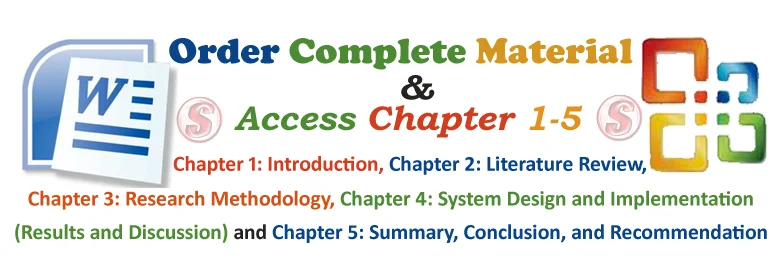Introduction
1.1 Background Of The Study
If anyone says education is expensive, let him or her try ignorant. The pursuit of education excellence has been one of the major goals of every nations of the world. It has been adjudged as the key with which any nation could permanently close the doors of poverty and ignorance and simultaneously open that of prosperity in terms of economic buoyancy, social environment and civilization.
However, the Nigerian content to the above view is of no difference. Constitutionally, education is a right for all citizens irrespective of social, cultural, economic, political, religional, tribal, mental, or physical status (Ajibade, 1993). That is, education is an instrument for effecting national development. Nigeria’s educational goals have been set out in the national Policy on Education in terms of the individual and the society (FGN, 2004). Towards this end, the National Policy on Education set up certain aims and objectives which are to facilitate educational development in the country. In fostering those aims and objectives, the teachers have important roles to play. The importance of teachers in any educational setting cannot be ignored. Without them, the school cannot exist. The government of Nigeria also recognized the importance of teachers when it says that no education can rise above the quality of its teachers (Wilson & Western, 2001).
As the history will have it, education was not as densely populated as this before, but due to civilization and white-colar-job saga, everybody wants to be educated and this led to development of everyone’s interest in education. In addition to this, Nigerian government through our colonial rulers later start contributing some percentage to some schools and this prompted parents to send their children to schools.
1.2 Statement Of The Problem
As a result of free education, the students’ enrolment began to increase tremendously to the extent that the ratio of teacher-students has now gone beyond control and the teachers are the one that translate educational philosophy and objectives into knowledge and skills and transfer them to students in the classroom as a safe, healthy and happy place with supportive resources.
According to the National Education Policy Center Policy Brief; “the policy brief summarizes the academic literature on the impact of class size and finds that class size is an important determinant of a variety of student outcomes, ranging from test scores to broader life outcomes…” Schanzenbach, D. W. (2014).
For all the aforementioned teachers’ functionalities to come to play, those teachers ought to be motivated and paid well so as for them to be effective and efficient towards their job.
To crown it all, when the class is to large and the salary is not encouraging, there is tendency for poor academic performance of the students. White House Report (2012).
The result of WAEC and NECO of Nigerian students is no longer what one can be proud of. The secondary school students and even parents are ready to pay any amount for special centre because of examination. Some teachers are even ready to write micro-sheet for their “candidate” to excel in national examinations and many more.
Class size, teachers’ pay and students’ academic performance is a great issue in Nigerian secondary schools in general, Ogun state in particular and with special reference to some selected schools in Sagamu as a case study.
The reason for this could be trace to ways and rate at which education growth is encouraged mostly in West, East and Southern part of Nigeria. The growth is really hyper. In the other way round, many upcoming ones do not dream of becoming a teacher as a result of poor payment of salary or salary delay and some other impetus that may be taking teachers’ concentration from their teaching profession.
If the above is the case, it will affect the students’ academic performance which may lead to inability to achieve the set educational aims and objectives and thereafter lead to backwardness among the rest countries of the World.
1.3 Purpose Of The Study
The specific purpose of this study were:
- To examine the number of students in class and what number ought to be per class of each school under study (students-teacher ratio).
- To examine how regular the teachers’ salary and others
- Examine the students’ academic performance at normal students-teacher’s ration and in an overcrowded classroom.
- To proffer valuable recommendations to the problems identified.
1.4 Research Questions
To accomplish the objectives of this study, the following under listed questions were answered:
- Can class size affect students’ academic performance?
- To what extent will teachers’ motivation, remuneration and prompt salary payment affect teachers’ efficiency and effectiveness in his/her teaching profession? And
- Will teachers’ attitude towards teaching and conducive environment affect the students’ academic performance?
- What are the likely solutions or recommendations to these problems?
1.5 Research Hypothesis
- There is no significant relationship between class size and students’ academic performance
- There is no significant relationship between teachers’ motivation, remuneration, prompt salary payment and students’ academic performance.
- There is no significant relationship between teachers’ attitude towards teaching, conducive environment and students’ academic performance.
- There is no significant relationship between the academic performance of the students taught by effective, moderately effective and highly effective teachers.
1.6 Significance Of The Study
One aspect in which this study was significant was that it used Nigerian background with a view to provide first hand information on the effect of size of the class and teachers’ pay on students’ academic performance in some selected secondary schools in Sagamu, Ogun State.
The students’ enrolment began to increase tremendously to the extent that the ratio of teacher-students has now gone beyond control. Students are increasing geometrically while teachers are not increasing, yet governments denied them of their right but they want them to contribute efficiently and effectively. Also, the teachers are the one that translate educational philosophy and objectives into knowledge and skills and transfer them to students in the classroom as a safe, healthy and happy place with supportive resources.
Therefore, this study was more significant to individual parent who whish their children well, teachers and government.
Government in the three tiers needs to put the necessity of prompt payment of teachers’ salary so as for country to have a good future.
1.7 Scope Of The Study
This study is restricted to the examination of effect of the class size and teachers’ pay on students’ academic performance. Due to time constrain, cost and other logistics reasons, the study was carried out in Ogun State and five schools shall be selected in Sagamu area.
1.8 Definition Of Terms
Class:
This is a room-like in which teaching-learning take place for a specific period
Teacher:
This is the experienced man or woman who is certified to impact knowledge to the lower learner
Pay:
This is an offering as a result of service rendering
Student:
This is the person that learn from the teacher
Performance:
This is the result that show that the student understand what he has been thought




